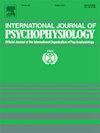Sokolov定向反射(OR)机制中的“放大器”:脑电图/ERP扩展。
IF 2.5
3区 心理学
Q3 NEUROSCIENCES
引用次数: 0
摘要
Sokolov的定向反射理论机制包括两个系统:神经元模型/比较系统和放大系统。其中第一种将相位或与引发刺激的参数联系起来;第二种通过生物体的唤醒状态来调节输出,反映在强音或上。关于OR的激发和习惯化的研究主要集中在神经元模型/比较系统的相位方面,而放大系统在很大程度上被忽视了。在这里,我们通过听觉习惯化/非习惯化研究的试验,使用皮电测量和中枢测量来检查相性和强直性OR谱。相性OR测量为皮肤电导反应(SCR)和P300 ERP分量,相应的强直性OR测量为刺激前皮肤电导水平(SCL)和刺激前脑电图α(8-13 Hz)振幅。我们预测,在每次刺激呈现时,兴奋的紧张性测量将调节相位或测量。两个阶段的措施显示出广泛的快速衰减重复标准,并恢复到一个偏差,与试验显著正相关。补益OR测量也显示出显著的变化,但呈显著的负相关:SCL减少,α增加。正如预测的那样,相位OR测量是由刺激前的强直OR水平调节的,在试验中,相位和强直OR模式之间存在很大的相关性。我们对Sokolovian OR理论预测的音调作为放大器方面的证据开辟了新的理论视角。识别相性和强直性的外周和中枢措施应促进手术室研究的扩大。本文章由计算机程序翻译,如有差异,请以英文原文为准。
The “amplifier” in Sokolov's Orienting Reflex (OR) mechanism: An EEG/ERP extension
Sokolov's theoretical mechanism of the Orienting Reflex (OR) includes two systems: a neuronal model/comparator system, and an amplifying system. The first of these relates the phasic OR to parameters of the eliciting stimulus; the second modulates output via the organism's arousal state, as reflected in the tonic OR. Research on elicitation and habituation of the OR has focussed largely on phasic aspects of the neuronal model/comparator system, with the amplifying system being largely ignored. Here we examine phasic and tonic OR profiles over trials from an auditory habituation/dishabituation study, using both electrodermal and central measures. Phasic OR measures were the skin conductance response (SCR) and the P300 ERP component, and corresponding tonic OR measures were the prestimulus skin conductance level (SCL) and prestimulus EEG alpha (8–13 Hz) amplitude. We predicted that the tonic measures of arousal at each stimulus presentation would modulate the phasic OR measures. The two phasic measures showed extensive rapid decrement over repeated standards, and recovery to a deviant, with a significant positive correlation over trials. Tonic OR measures also showed significant changes over trials, but with a significant negative correlation: decrement in SCL, increment in alpha. As predicted, the phasic OR measures were modulated by the prestimulus tonic OR levels, with large correlations between the phasic and tonic patterns over trials. Our evidence for the predicted tonic-as-amplifier aspect of Sokolovian OR theory opens new theoretical perspectives. Identification of both phasic and tonic peripheral and central measures of the OR should prompt an expansion of OR research.
求助全文
通过发布文献求助,成功后即可免费获取论文全文。
去求助
来源期刊
CiteScore
5.40
自引率
10.00%
发文量
177
审稿时长
3-8 weeks
期刊介绍:
The International Journal of Psychophysiology is the official journal of the International Organization of Psychophysiology, and provides a respected forum for the publication of high quality original contributions on all aspects of psychophysiology. The journal is interdisciplinary and aims to integrate the neurosciences and behavioral sciences. Empirical, theoretical, and review articles are encouraged in the following areas:
• Cerebral psychophysiology: including functional brain mapping and neuroimaging with Event-Related Potentials (ERPs), Positron Emission Tomography (PET), Functional Magnetic Resonance Imaging (fMRI) and Electroencephalographic studies.
• Autonomic functions: including bilateral electrodermal activity, pupillometry and blood volume changes.
• Cardiovascular Psychophysiology:including studies of blood pressure, cardiac functioning and respiration.
• Somatic psychophysiology: including muscle activity, eye movements and eye blinks.

 求助内容:
求助内容: 应助结果提醒方式:
应助结果提醒方式:


